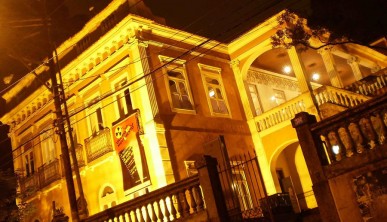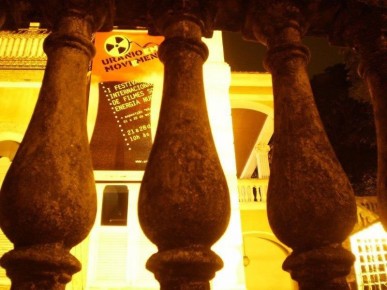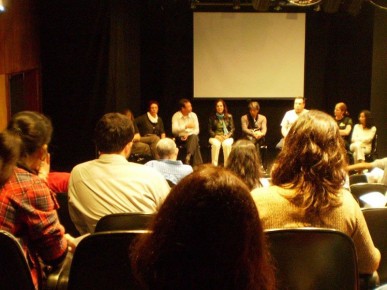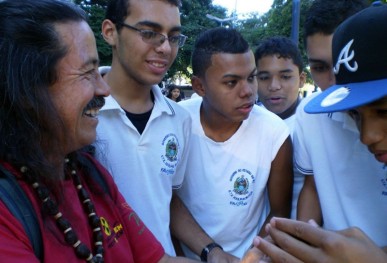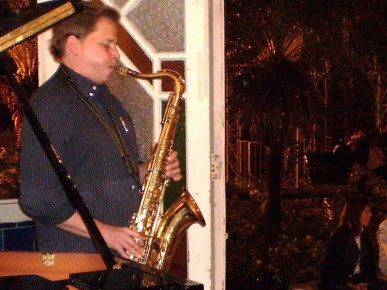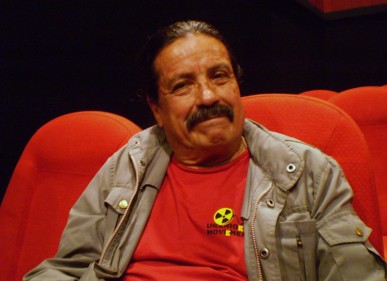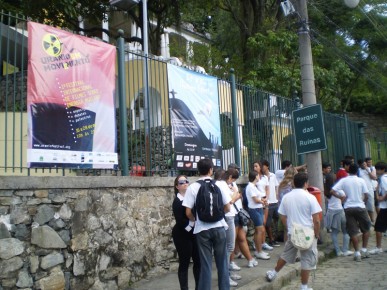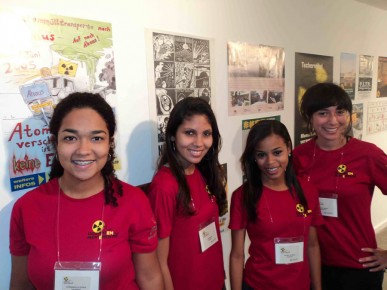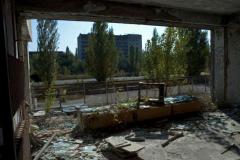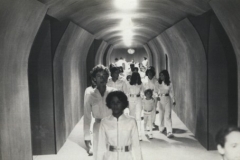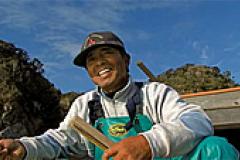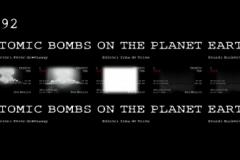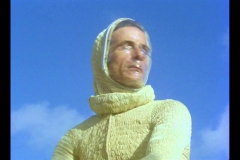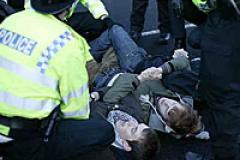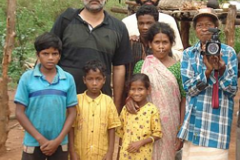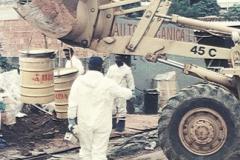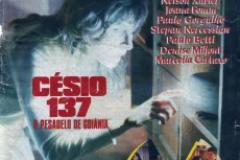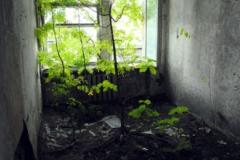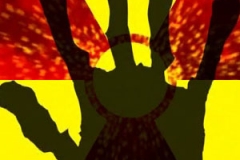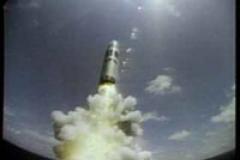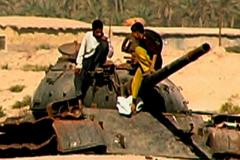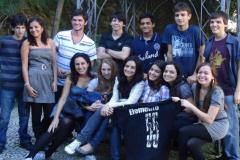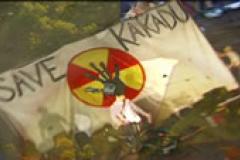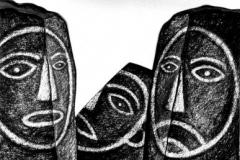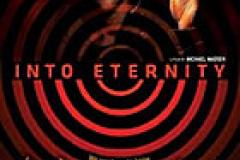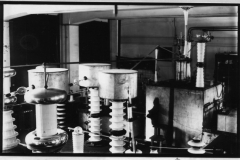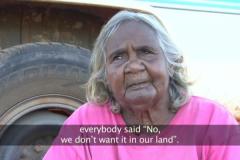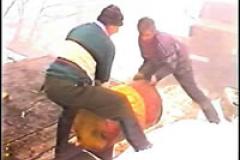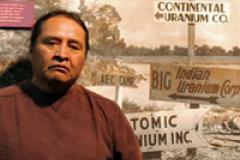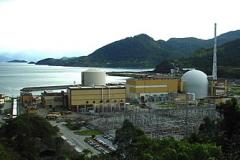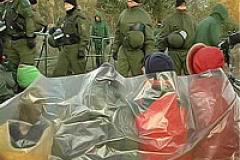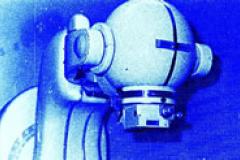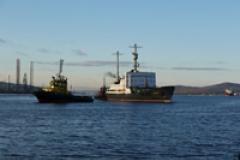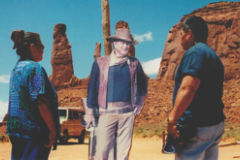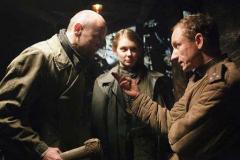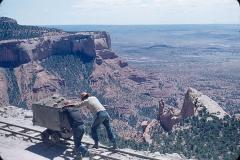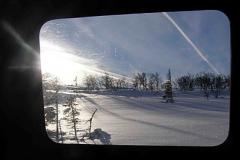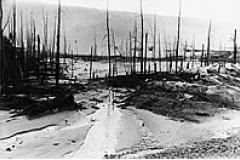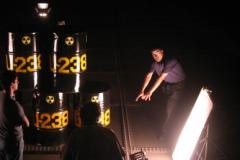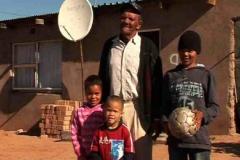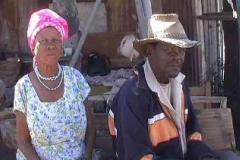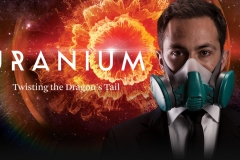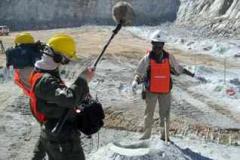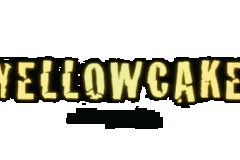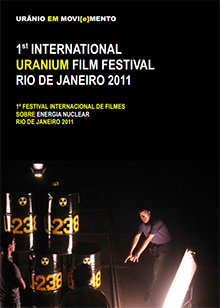 Climate Change, the Peak Oil and the still growing hunger for energy of the modern societies on all continents: At the beginning of the 21th century the world is - like at the beginning of the 19th century - again in the search for a new direction. Is nuclear energy the solution for Climate Change and the growing demand for Energy as it is claimed by nuclear industry and scientists like JamesLovelock, the author of the Gaia theory?
Climate Change, the Peak Oil and the still growing hunger for energy of the modern societies on all continents: At the beginning of the 21th century the world is - like at the beginning of the 19th century - again in the search for a new direction. Is nuclear energy the solution for Climate Change and the growing demand for Energy as it is claimed by nuclear industry and scientists like JamesLovelock, the author of the Gaia theory?
Windscale (Sellafield), Harrisburg (Three Mile Island), Chernobyl, Goiânia: Radioactive and nuclear power accidents happen. Mining companies spreading around the world in search for new uranium deposits. And on the other side concerned citizens and indigenous peoples fighting against uranium mining projects in countries like Australia, India, Niger, Namibia, USA, Canada or Portugal. Are the democratic world societies - especially in emerging countries like Brazil, China, India or South Africa – prepared to make the right decisions? Do the people really know what radioactivity, what nuclear power means?
That was the background 2010 when we created – one year before Fukushima - the First International Uranium Film Festival in Rio de Janeiro: The first annual film festival to highlight nuclear and radioactive issues. A film festival to inform especially the Latin American and Portuguese speaking societies and to stimulate world-wide the production of independent documentaries and movies about the whole nuclear fuel chain from uranium mining to nuclear waste deposits; about atomic bombs and about the use and risks of radioactivity and radioactive elements in general.
We started the call for entry May 2010, and March 2011 - when we already had selected over 30 documentaries and movies from all continents - happened the nuclear accident of Fukushima!
Finally between 16th and the 28th of May we screened 33 selected films in the competitive category and 4 documentaries, which were not part of the competition, in Rio de Janeiro. The screening locations were CINEMAISON in the city centre and in Santa Teresa the theatre of the Centro Cultural Parque das Ruinas and the theatre of the Centro Cultural Laurinda Santos Lobo. We had an audience in total of more than 1000 people, many of them students and teachers.
Beside of the screenings we organized - as part of the Festival - two important and successful Exhibitions: "Maõs de Césio", a photo exhibition about the nuclear accident of Goiânia 1987 with the element Caesium 137, the worst radioactive accident of Latin America. The exhibition in the Cultural Centre Laurinda Santos Lobo attracted more than 500 visitors - not included the audience of the Film Festival. The exhibition can now travel to other cities. At the moment it is only in Portuguese, but the Idea is to have it also in English and Spanish and to bring it to other countries. The other exhibition was based on Radiating Posters selected by the Amsterdam based institutions WISE and Laka Foundation: 40 original posters of the global anti-nuclear movement. That exhibition in the gallery of the Cultural Centre Parque das Ruinas was also visited by hundreds of Cariocas and tourists. Satellite festivals were organized in São Paulo, Recife, João Pessoa, Natal, Fortaleza e Salvador. Further screenings are planned also in other countries like USA, Germany, Sweden and South Africa.
Norbert Suchanek
Catalogue of the Festival 2011 - PDF
SPONSORS & SUPPORTERS 2011
The First International Uranium Film Festival and its side events were supported by
- Heinrich Boell Foundation - Rio de Janeiro
- (http://www.boell-latinoamerica.org/web/11.html)
- Fundação de Apoio à Escola Técnica (FAETEC)
- Escola Técnica Estadual Adolpho Bloch da Faetec
- Centro Cultural Municipal Parque das Ruinas
- Centro Cultural Municipal Laurinda Santos Lobo
- Prima (www.prima.org.br)
- Programa Memória Roberto Pires
- Fundação Nacional de Arte (FUNARTE)
- Universidade Federal de Goiás - Pró-Reitoria de Pesquisa e Pós-Graduação
- Universidade Católica de Goiás PUC-GO/IGPA
- Centro Cultural Matilha São Paulo (www.matilhacultural.com.br)
- Latin America Bureau (www.lab.org.uk)
- Latin America Film (www.latamfilm.com)
- The Business & Human Rights Resource Centre (www.business-humanrights.org)
- Portal EcoDebate (www.ecodebate.com.br)
- Rubens Maia (Artist)
- Felipe Velloso (Combinado Estúdio)
- Restaurante & Bar do Mineiro
- Armazém São Thiago
Special Thanks goes to the volunteer translators:
Daniel Cahill, Morgana Azevedo Moreira, Camila Costa, Joy Gomes, Vanessa Marcondes de Souza, Denis Astbury, Professor Rubem, Eugenia Gay and Baptiste Rogues
and further Special Thanks goes to
Tuane Martins, Sebastião Jorge and Rosane Sertório
to our Portuguese-English interpreter Luiz Augusto Silveira
to the represents of the indigenous people of Brazil
Afonso Apurinã, Tapiti Guajajar, Naiara do Sol of the Centro de Culturas Indigenas
Aldeia Maracanã for their performance during the Award Ceremony
and to the musicians...
Wolffram and Lennart (www.jazztopia.org)
Juliano Pires and Os Siderais (Brazilian Brass Band)
and last but not least to
Haroldo Mota, president of Baobá and Co-Director
for the Uranium Film Festival Events in the Cities of Northeast Brazil
PROGRAM
(Un dimanche à Pripiat)
France, 2006, 26 min, English
Written and directed by Blandine Huk & Frédéric Cousseau.
Somewhere in Europe there is a forbidden zone. Lying in the heart of this zone is Pripyat, at one time a model city inhabited by some 50,000 people. On April 26, 1986, an invisible enemy forced the residents of Pripyat to evacuate the area in order to escape. Pripyat was home to the Chernobyl Nuclear Power Plant workers. It was abandoned in 1986 following the Chernobyl disaster.
A Sunday in Pripyat is a testimony to environmental and human destruction caused by the Chernobyl nuclear power station disaster.
ABRIGO NUCLEAR - Brasil, 1981, Director and Producer Roberto Pires. Fiction, 86 min, Portuguese with English subtitles. Brazil´s first science fiction questioning the use of nuclear power. In the future the Earth's surface is radioactive polluted, because of the atomic waste of nuclear power plants. The population is forced to live in underground nuclear shelters. http://www.memoriarp.com
Roberto Pires died 2001.
Japan, 2010, 116 min. English
For 28 years, the people of Iwaishima Island, living in the middle of the bountiful Inland Sea, have been opposing a plan to build a nuclear power plant. The island has a 1000 - year history during which people have preserved their traditional festival. Takashi, the youngest on the island , is struggling to earn his living. He dreams of a life based on sustainable energy. Meanwhile, communities in Sweden are making an effort to implement such lives. The people living in the Arctic circle have taken action to overcome damage from the global economy. On Iwaishima, Mr. Ujimoto has begun sustainable agriculture by reclaiming aban-doned farmlands. But a power company tries to fill in a bay to create man-made land. The people of the island set sail together to stop the construction of the nuclear power plant. A fight breaks out on the sea.
“Ashes to Honey” reached the Uranium Film Festival after the selection process, but because of its importance and because of Fukushima we selected it for the noncompetitive category.
UK/The Netherlands | 2011 | 13 min | Art & Experimental documentary
Director: Peter Greenaway, Video Design Irma de Vries
Producer: Change Performing Arts www.changeperformingarts.com | Language: Multilingual
Synopsis: Very surprisingly from 1945 to 1989 there have been 2201 atomic bombs dropped on the planet Earth - an astonishing number of atomic bombs implying huge destruction and fall-out. The film shows evidence of every bomb explosion documented with the nation responsible, the date and location, the force and the height about earth or sea level in a relentless build up of accumulating destruction that is both inspiring and dreadful in the true biblical sense of the phrase - full of dread.
Video: https://www.youtube.com/watch?v=Mc3EKAszRAw
Awards: International Uranium Film Festival Hors Concours Award, Rio de Janeiro 2012
BAHIA SCI-FI - Brazil, 2015, Director Petrus Pires, Production Iglu Filmes. Documentary, 30 min, Portuguese with English subtitles. This film documents the making of the movie "Abrigo Nuclear" by Roberto Pires.
United Kingdom, 2010, 71 min, English
Directors and Producers: Meera Patel and Wolfgang Matt
Production: Maddmovies
Documentary
A story about the biggest weapons of mass destruction ever created, the people who use them and, more importantly, the people who fight them. 'Beating the Bomb' charts the history of the British peace movement against the backdrop of the atomic age. The film also frames the nuclear weapons issue within the wider context of global justice.Beating the Bomb, United Kingdom, 2010, 71 min.
www.beatingthebomb.com, contact: maddmovies@gmail.com
"Beating the Bomb" was selected by the Uranium Film Festival Jury as one of the eight best documentaries of the festival.
Best documentary award, Red Rock Film Festival, Utah, USA
(Ragi Kana Ko Bonga Buru)
India, 1999, 52 min, English
Documentary
Not part of the Competition
"Buddha Weeps in Jadugoda" is a documentary film on uranium mining and its deadly impacts on the tribal people living near the Jadugoda mine, mill and tailings dam, in the East Singhbhum district of Jharkhand (India). Unsafe mining, milling and tailings management by UCIL in this area for almost 30 years has resulted in excessive radiation, contamination of water, land and air, destruction of the local ecology, and lead for to genetic mutation, and slow death for the people of the region. The film attempts to depict the gross misuse of power by the authorities in displacing the original inhabitants of the region, the utter lack of concern for internationally accepted norms and safety precautions in the handling of uranium and its by-products, and their callousness of its disastrous impact on the people and the region.
Director Shri Prakash present, Berlin 2012
Q&A with Shriprakash + RAOUF DABBAS, Amman 2014
(Césio 137 – O Brilho da Morte)
Brazil, 2003, 24 min
Director: Luiz Eduardo Jorge, Producer: Laura Pires
AUDIENCE AWARD BEST SHORT FILM 2011
That Brazilian short film shows the events of a real live tragedy about the release of radioactive Caesium-137 into a populated area in 1987 in the city of Goiânia, Brazil. It was the worst radioactive accident in Latin America, which cost the lives of many people and the health of hundreds or possibly thousands of survivors.
15 years of pain, fear, panic and doubt. Discrimination, segregation and death of victims of one of the world's largest radiological accident, with irreversible damage to people and environment. The screenplay is based on testimonies of the victims.
Brazil, 1989, 95 min, Portuguese, English subtitles
Producer: Laura Pires
Doc Fiction
AUDIENCE AWARD BEST FEATURE FILM 2011
In the ruins of a demolished hospital for cancer treatment in the centre of the Brazilian city Goiânia, two young men found an old "forgotten" Teletherapy Unit, which contained a highly radioactive "Caesium 137 bomb". They sold it to a local scrap metal dealer, who opened that Pandora's box. People were fascinated by the dazzling blue light of the caesium crystals. But they did not know, that it was the shine of the death. Hundreds if not thousands of the citizens and visitors of Goiânia became victims of Caesium 137. The script of the movie is based on statements by the victims and medical personal attending the victims, taken by Roberto Pires at the time of the accident.
(Tchernobyl, Une histoire naturelle)
France, 2009, 90 min
Directed by Luc Riolon
Produced by Camera Lucida Productions, www.cameralucida.fr
On April 26th 1986, reactor n°4 at the Lenin power station in Chernobyl went out of control, leading to the consequences we all know: radioactive fallouts contaminating huge pieces of land, the creation of a 30-km-radius exclusion zone around the power station. In this now forbidden zone, the wild fauna and flora were left to their fate. What happened to this wildlife, freed from human pressure but immersed in the Chernobyl radioactive "hell"? For scientists, the Chernobyl forbidden zone has become an openair laboratory, a tragically unforeseen but huge laboratory. This is a strange noman's land where geo-chemists, zoologists and radioecologists are making disconcerting discoveries.
“Chernobyl, a Natural History?” was selected by the Uranium Film Festival Jury as one of the eight best festival documentaries.
Australia, 2007, 30 min
Directed by Scott Ludlam
Produced by Anti-Nuclear Alliance of Western Australia, www.anawa.org.au
Climate change, nuclear power and the energy revolution: Climate of Hope is a 30 minute documentary created to demystify climate change and nuclear energy. While the threat of climate change is now widely accepted in the community, the potential for a host of nuclear power stations in Australia has raised questions about the best strategy for our country to move to a low-carbon economy. This animated documentary takes viewers on a tour through the science of climate change and the nuclear fuel chain and the remarkable energy revolution that is under way.
“Climate of Hope” was selected by the Uranium Film Festival Jury as one of the eight best festival documentaries.
USA, 1991, 29 min
Documentary
The documentary uncovers the disastrous health and environmental side effects caused by the production of nuclear materials by the General Electric Corporation. The film juxtaposes GE's rosy "We Bring Good Things to Life" commercials with the true stories of people whose lives were devastated by the company's involvement in testing and making nuclear weapons. Driven by intensely personal testimony and painstaking research, "Deadly Deception" exposes what GE never wanted its customers to know: a shocking pattern of negligence and misinformation spanning several decades. Nine months after this film won the Oscar®, GE pulled out of its work in the nuclear weapons industry, and Corporate Accountability International organizers of the GE boycott, declared victory in their grassroots campaign. The 1991 Academy Award®- winner for Best Short Documentary, Deadly Deception unco-vers the disastrous health and environmental side effects caused by the production of nuclear materials by the General Electric Corporation. The film juxtaposes GE's rosy "We Bring Good Things to Life" commercials with the true stories of people whose lives were devastated by the company's involvement in testing and making nuclear weapons.
Contact: www.groundspark.org
Germany, 2006/2007, 93 min, German
Director: Frieder F. Wagner, Email: ochowa-film@t-online.de
The film accampanies Prof. Guenther, specialist for tropic diseases and epidemiologist, and his expert colleagues as they research on the effects of depleted uranium ammunition used in Iraq, Kosovo, Bosnia, although long since banned ba Hague and Geneve Conventions. The ammunition penetrates steel like a knife slices butter and then explodes into radioactive nanoparticles that disperse: Winds can carry them clear across our planet. Unnoticed by all in contact with them, they flow through bodies like water through a sponge, leaving behind a path of destruction through the cells they crossed. In their search for contaminated battle fields. Prof. Guenther and fellow scientists discover, for example in Iraq, areas, in which radioactive contamination is 30.000 times higher than Earth's natural radiation level.
Frieder Wagner is present during the screening.
(Elemento 55)
Brazil, 2008, 36 min
Directors and Producers: Daniela Mazur, Ana Rios, Ricardo Busquêt. Colégio Santa Mônica of São Gonçalo
It is a short fiction movie made by Students of the School Colégio Santa Mônica of São Gonçalo (Rio de Janeiro). It is based on the radioactive accident 1987 in the city of Goiânia with the chemical element with the atomic number 55, also called Caesium 137.
“We selected Element 55 as a good example for other students and schools to produce their own films about nuclear and radioactive issues. It must not be a film about an accident like in Goiânia. I could be also a simple documentary about radioactive waste of the hospital in your neighborhood.” - Marcia Gomes de Oliveira
Australia 2001/2002, 62 min
Writer/director/camera: Pip Starr
Rockhopper Productions, www.rhproductions.com.au
The documentary took 4 years and 4 weeks to complete. It tells the story of one of Australia's largest ever land rights and environmental campaigns, the fight to stop the building of a second uranium mine within Kakadu National Park. Made with the cooperation of the Mirrar aboriginal clan, the owners of the land on which Jabiluka is proposed to be built. Whatthe film makes clear is that the Land Rights Act has is not enabling aboriginal people to control activities on their land, and that their political and cultural rights continue to be eroded. Fight for Country is a powerful and inspiring story of an aboriginal nation standing up for their country, and of the non-indigenous Australians who stood with them.
USA | 1997 | 9 min | Animation
Director: Karen AQUA (1954 - May 30th, 2011) | Music by Ken Field
Language: No Dialogue
Synopsis: In south-central New Mexico, an ancient Native American rock art site lies 35 miles from the detonation site of the world’s first atomic bomb. The juxtaposition of these sites points to the striking contrast between the two worlds which created them: one which reveres and lives in harmony with the natural world, and one which, in striving to control the forces of nature, has created a means for its destruction. Film director's website: http://karenaqua.com
Awards:
Humboldt International Film Festival, CA, 1998: 1st Prize, Animation
Marin County National Festival of Short Films, CA, 1998: 1st Prize, Animation
Green Extreme Film Festival, Canada, 1999: Best Environmental Film
Prix Leonardo, Italy, 1999: Gold Certificate
International Uranium Film Festival SPECIAL ACHIEVEMENT AWARD 2012
(Hibakusha - Unser Leben zu Leben)
USA, 2010, 78 min, English with German subtitles.
Memory Productions
Documentary
The stories of Japanese, Korean, and American Hibakusha: Survivers of the atomicbombs. Their stories are linked to the relationship between Eiji Nakanishi (one of youngest survivors of Hiroshima) and his little friend, Yoko, an eight year old girl he teaches to play the guitar. Little by little she learns about Eiji's hiba-kusha experience. She becomes intrigued by colorful pictures and drawings made by the survivors. Then she discovers Sadako and the story of the Thousand Cranes. "Will Eiji take me to thePeace Festival in Hiroshima?" The bombing of Nagasaki is shown through the sharp focus of a Shinto wedding ceremony. Back in America, Davey throws down his tin pot and wooden spoon of his Hiroshima-Nagasaki celebrations.
IMPRESSION: XPS-160 - Iran, 2013, Director Tiyam Yabandeh Jahroumi. Fiction, 15 min, no dialogue - Its about a blind photographer who lives in a dark room with his dead wife memories,after an nuclear war...it is a sci-fi/drama film about love. A post-apocalyptic tale of a blind photographer who lives in a dark room . . . when you look closer the worlds it looks like a Sci-Fi films that made in 70th decade, the world is full of war, rage, injustice, we are all robots,..... some thing is missing: sure LOVE. The universe is Pregnant a war. . . world war 3 and it is absolutely a nuclear war. . . “I think LOVE is a spirit and it can not be vanished even with a nuclear bomb…”
Denmark, 2010, 75 min
Director: Michael Madsen
Producer: Lise Lense-Möller / Magic Hour Films
This film explores the question of preparing the site so that it is not disturbed for 100,000 years, even though no structure in human history has stayed standing for such a long period of time.
"Every day, the world over, large amounts of high-level radioactive waste created by nuclear power plants is placed in interim storage, which is vulnerable to natural disasters, man-made disasters, and societal changes. In Finland, the world's first permanent repository is being hewn out of solid rock – a huge system of underground tunnels – that must last the entire period the waste remains hazardous: 100,000 years."
Once the repository waste has been deposited and is full, the facility is to be sealed off and never opened again. Or so we hope, but can we ensure that? And how is it possible to warn our descendants of the deadly waste we left behind? How do we prevent them from thinking they have found the Giza pyramids of our time, mystical burial grounds, hidden treasures? Which languages and signs will they understand? And if they understand, will they respect our instructions?
Experts above ground strive to find solutions to this crucially important radioactive waste issue to secure mankind and all species on planet Earth now and in the near and very distant future."
Into Eternity won the Jury Award as the best feature film of the 1st International Uranium Film Festival of Rio de Janeiro 2011.
(La guerre radioactive secrète)
France, 2000, 64 min
Director: Martin Meissonnier
Contact: www.campagnepremiere.fr/uranium.html
After 1991 in Irak, many children are born with malformation, in the USA, hundred of thousands of soldiers have gulf War disease and their children have malformation too. This film is an inquest on Depleted Uranium featuring 2 whistle lowers inside the Pentagon and US declassfied documents, and interviews with the deputy secretary of state in charge of the Gulf war disease.
MEMORIES OF THE KYOTO CYCLOTRON - Japan, 2009, Director and Producer Maika Nakao. Documentary, 62 min, Japanese and English with English subtitles - Film that pieces together the fragmentary records of Japan’s attempts to develop a nuclear weapon during the second world war. The film presents a multifaceted view of the complex relationship between nuclear Science and its practical application, and how Japanese society has dealt with the memories and legacies of its past involvement with nuclear science.
Australia, 2010, 10 min
Documentary
Muckaty Voices is a short film capturing Aboriginal community resistance to an Australian government plan to dump low and long lived intermediate level radioactive waste at Muckaty Station, 120km north of Tennant Creek in the Northern Territory. The government's push for Muckaty has sparked widespread criticism from the targeted community, trade unions, national health and environment groups and Indigenous organizations. A federal court challenge has been launched to contest the Muckaty nomination. The film presents the country and community affected by this proposal.
The film was produced for the Muckaty Traditional Owners by Enlightning Productions, with support of Beyond Nuclear Initiative: www.beyondnuclearinitiative.com
Georgia / Netherlands, 2003, 16 min
Directors: Janita Top & Marij Kloosterhof
Contact: Stichting Falkor, info@falkor.org
In June 2003 police in Tiblisi, Georgia (South Caucasus) seized a taxi which was transporting radioactive sources Caesium and Strontium. The owner of the vehicle said, he knew nothing about the contents of the freight. Even a tiny fraction of strontium, if inhaled or ingested, can cause cancer. This is an example of the socalled orphaned sources: radioactive materials that are lying around in a former Soviet republic. They have been found in forests and rivers, and in the city. Some of these materials were left behind by the Soviet army, after the collapse of the Soviet Union, some found their way to Georgia via illegal trading. In the Caucasus, places where nuclear waste is stored have not always been well regulated. Large amounts of waste have been stolen by soldiers and citizens, hoping to make money out of it. In 1997 eleven Georgian soldiers were exposed to radiation and became ill. In winter 2002, three residents of Tsalenjikha, western Georgia, suffered severe injuries due to exposure to a strontium source. The issue radioactive pollution is politically sensitive. Governments seem to be closing up about the subject and information is difficult to obtain. Moreover, since 11th of September the subject radioactive materials is also being connected to 'the war on terrorism' (Georgia is neighbor of Chechnya) and illegal trading of sources.
USA, 2007, 37 min
Director: Jenny Pond, produced by Norman Patrick Brown & Jenny Pond.
Advisor: Manuel Pino, Recipient of the Nuclear Free
The film tells the story of a corrupt government, unconscionable greed and a policy of destruction aimed at the Aboriginal Homelands of Indigenous People from the 1940's until today. It is a documentary about uranium mining and the devastating effect it has on the people, livestock, water and agriculture in the 4 Corners area of the US and the Grand Canyon. The path of POISON WIND has taken us to political and environmental activists within the Navajo Nation (Diné) and Pueblo People (Acoma and Laguna) of New Mexico, Western Shoshone, Hualapai and Havasupai where today many people suffer relentlessly from the effects of living near radiation contaminated lands. POISON WIND highlights the greed of mining companies that set out to destroy the balance of life created by the people of these lands...sacred to so many and offering only a death sentence in the end. This film is a "Visual Oral History" which comes from the people themselves and only serves to focus on their stories, as they speak from their hearts about how uranium mining left them victims of where they live.
Future Award 2008
Info: Poisonwindmovie.wordpress.com
(Pedra Podre)
Brazil, 1990, 26 min, Portuguese with English subtitles
Documentary
It is the first Documentary made about the Brazil's nuclear power plants, Angra 1 and Angra 2 in the Atlantic Rainforest region in the South of Rio de Janeiro. With ironic humor, it shows that the official safety and evacuation plans to protect the local population and tourists in case of a nuclear meltdown are just a joke. Worse: Angra 1 and 2 are constructed on a beach, which the indigenous population (Guarani-Mbyá) called once Itaorna: Rotten Rock.
(Der zehnte Castor-Transport nach Gorleben)
Germany, 2007, 43 min
Protests against Nuclear Waste Transports in Germany: Nowhere on earth has the nuclear industry found a safe way to keep waste that will remain dangerous for at least a million years. In Germany politicians decided 30 years ago that a salt deposit near the village of Gorleben in the north of the country should be the permanent repository, and a prefabricated storage hall next door to it the "interim storage". Scientists almost from the outset ruled the salt dome unsafe.
The 800 people living near Gorleben and several thousand others living in a cluster of villages and small towns in the picturesque farming and forestry area have fought the nuclear plans and the transportation of waste to the storage from the beginning. The recycled waste from German power stations comes from a plutonium plant in northern France in so-called Castor caskets.
We have filmed the protests against the tenth such transport to Gorleben in November 2006. You will see how after 30 years the people living near Gorleben and the thousands who join them from all over Germany once a year when the Castor train comes are not tired of revolting against this nuclear madness. The film deals with people who sit down on railway tracks and roads, usually in bitter cold, sometimes brutalised by police. It asks them where they find the courage and the motivation to resist again and again, but also about their fear and their powerlessness when facing an army of up to 20,000 police and the annual militarisation of a whole region.
Contact: cinerebelde@cinerebelde.org
(O Pesadelo é Azul)
Brazil, 2008, 24 min, Portuguese/German, English subtitles
In 1987 in Goiânia took place one of the biggest radioactive accidents of the world. Twenty years later the survivers are telling what happened and about their live after the accident. The short film won the Award as best documentary of the 6thABD Cine Goiás Festival (Troféu Pedra Goiâna) 2008.
(История ядерного судна)
Russia, 2003-2004, 18 min
Director: group of authors of Bellona-Murmansk, contact: www.bellona.org
This film tells about the most dangerous ship in the Northern Europe called Lepse. The ship, which stores onboard tones of spent nuclear fuel, has become a grave illustration of the problems haunting the Russian nuclear fleet and the international efforts aimed at solving those problems. It will take Russia many more years to manage with nuclear and radiation problems, left due to nuclear heritage of the USSR and the Cold War.
Bellona-Murmansk is an environmental NGO, established in North-West Russia, in Murmansk. The work of the NGO is devoted to solving problems of nuclear and radiation safety, development of renewable sources of energy, climate change, safe oil and gas industry development. Experts of the organization make researches and publish reports, position papers.
Germany, 2011, 43 min
Director Ralph Weihermann & Susanne Friess
www.kigali-films.de
Radiating Future is the first documentary about the uranium mine Caetité in the Northeast of Brazil in Bahia. Mining started there in 2000. Since that time population and environment are in risk because of radioactive pollution.
“O futuro irradiante do Brasil” was produced only a week before the Uranium Film Festival started. Because it is the first film about the Brazilian uranium mine Caetité and its importance for Brazil we selected it for the non-competitive category.
USA 2000/2008 | 57 min and 15 min Epilogue | Documentary
Director: Jeff Spitz | Produced by Jeff Spitz and Bennie Klain
The film chronicles an extraordinary chain of events, beginning with the appearance of a 1950s film reel, which lead to the return of a long lost brother to his Navajo family. Living for more than six decades in Monument Valley (on the Arizona/Utah border), the Cly family has an extraordinary history in pictures. Since the1930′s, family members have appeared as unidentified subjects in countless photographs and films shot in Monument Valley including various postcards, Hollywood Westerns and a rare home-movie by legendary director John Ford. But it is the sudden appearance of a rarely seen vintage film that affects their lives the most. With the return of “Navajo Boy,” Elsie seizes the opportunity to tell her family’s story for the first time, offering a unique perspective to the history of the American west. Using a variety of still photos and moving images from the 40s and 50s and telling their family story in their own voices, the Clys shed light on the Native side of picture making and uranium mining in Monument Valley.
The Return of Navajo Boy, an official selection of the Sundance Film Festival and PBS, is an internationally acclaimed documentary that reunited a Navajo family and triggered a federal investigation into uranium contamination. It tells the story of Elsie Mae Begay, whose history in pictures reveals an incredible and ongoing struggle for environmental justice. A powerful new epilogue (produced in 2008) shows how the film and Groundswell Educational Films’ outreach campaign create news and rally supporters including Congressman Henry Waxman (D-CA). The Chairman of the Committee on Oversight and Government Reform mandated a clean-up plan by the five agencies that are responsible for uranium contamination.
The documentary, epilogue and now 15 webisodes have leveraged several remarkable impacts: Bernie Cly, one of the Navajo family featured, has been awarded $100,000 in compensation from the US government; the EPA demolished a dangerous house made out of uranium which was featured in the film and completed its $8 million dollar clean up of the abandoned uranium mine located in the backyard of the Navajo family featured in the documentary. The most recent webisode in April 2014, informs viewers that the Navajo tribe won the largest environmental settlement in American history, $1 billion payout from Kerr-McGee, the corporate contaminator exposed by the documentary.
Filmwebsite: www.navajoboy.com
Awards:
2000, Best Documentary, Indian Summer Festival
2000, Programmer's Choice Award, Planet in Focus Film Festival, Canada
2000, Audience Award, Durango International Film Festival
2000, Official Selection, Sundance Film Festival
(Der Uranberg)
Germany, 2010, 89 min, German
Contact: www.saxonia-media.de
The world in 1947: The Cold War has begun. The nuclear arms race between USAmerica and Russia becomes a threat to mankind. The arms race is decided in the Ore Mountains. That is where the Soviets had the Germans mine uranium for the construction of their first atom bomb without any consideration for the actual costs. The repatriated prisoner of war and miner Kurt Meinel (Vinzenz Kiefer) falls in love with Lydia (Nadja Bobyleva), the daughter of the Russian Major Burski (Henry Hübchen) – a dangerous love affair. When they become involved in a mining disaster, their secret love is tried to the breaking point. Lydia's father has to decide between the life of his daughter and carrying out his orders: to mine uranium to preserve peace. Filled with suspense and emotional impact, the film DER URANBERG tells the story of human tragedy as part of an almost unknown chapter of German history which affected world politics.
USA, 2010, 11 min
Executive Productions: First Nations Development Institute, Seventh Generation Fund, Western Action Mining Network, Navajo Waters
Documentary
The waters and health of Native and non-Native communities near the Grand Canyon and across the Southwest have been contaminated by decades of uranium mining and milling. Today, thousands of new uranium mining claims have been filed on the Colorado River Watershed, and directly threaten the water supplies of 25 million people. Join us in a conversation to help us understand more about Uranium.
(Om bergen faller sönder)
Sweden, 2011, 35 min
Director and Producer: Klara Sager
Under the Surface (Om bergen faller sönder) is a documentary about uranium exploration in the north of Sweden. Barbro owns the local grocery shop in the beautiful mountain area of Hotagen. One day terrain vehicles and men with geiger indicators shows up at her shop. Something in the mountains attracts them - there has been a discovery of uranium. Soon several exploration companies arrives to the area. The mountain area is also what is left of the native land for two Sami comunities. They now see a severe treath to their possibilities to survive as a indigenous people. A film about the villagers conflict with the companies and about the hidden sides of nuclear power. It's also a story about the alarming crises of the modern world where people and nature is sacrificed in the name of development.
"Om bergen faller sönder" was selected by the International Uranium Film Festival Jury as one of the eight best documentaries of the festival.
Canada | 1990 | 48 min | Documentary
Director: Magnus Isacsson (1948 - August 2, 2012) | Producer: National Film Board of Canada
Language: English and French
Synopsis: This film exposes the ethical and environmental problems which surround the practice of uranium mining in Canada. The film delivers some hard-hitting and little known facts about the detrimental impact of uranium mining on the environment as well as on the health of those employed in the industry. Toxic, radioactive waste is a severely detrimental by-product of uranium mining, which has been proven to cause profound, long-term environmental damage. The same radioactive waste puts the miners at extreme risk for developing cancer. Finally, because most of the mining to date has been conducted on land historically used by Canada's Native populations, uranium mining violates the traditional economic and spiritual lives of many aboriginal peoples.
Film info: www.socialdoc.net/magnus
Trailer: https://www.nfb.ca/film/uranium
Awards:
Golden Sheaf Award at the Yorkton Film Festival in 1991
(Uranio 238: La Bomba Sucia del Pentágono)
Costa Rica, 2009, 28 min, English, Spanish subtitles
Producer Isabel Macdonald and San José Quaker Peace Center
Documentary
Uranium 238 depicts the hazards that the use of depleted uranium or DU in conventional weapons poses for the health of soldiers and civilians. Through interviews with soldiers, scientists and activists, the documentary explores the health hazards when this radioactive and toxic material is ingested or inhaled by people in the battle fields and shooting ranges. Based in scientific data this video has been used by the International Coalition to Ban Uranium Weapons (ICBUW) as part of its international campaign to prohibit DU as a military component.
URANIUM 238 - The Pentagon´s Dirty Pool won the Jury Award as the Best Short Film of the First International Uranium Film Festival 2011.
South Africa, 2007, 52 min
Director: Theo Antonio
Producer: Jenny Hunter
Uranium Road is a penetrating documentary which rips the veil of secrecy from both the past and present South African nuclear programmes, showing how the nuclear industry creates closed cliques of the powerful and fundamentally undermines the democratic principles of our young democracy, repeating past mistakes. It exposes the billion rand industry that relies on a technology whose safety and economy has yet to be proven. It combines archival footage, interviews with local and international experts and tells of a community on the edge of a nuclear waste dump in scenic Namaqualand, cutting to the core of our democracy.
Brazil, 2010, 27 min, English with German subtitles
This documentary is about uranium mining and uranium prospecting in Namibia and its effects on the local population, environment and the scarce water resources of the Kuiseb Valey. Namibia has 2 uranium mines. Another 10 are planned. Exploration is going on in the territory of the Topnaar-Nama people. Their natural resources, their water and life are jeopardized. Uranium mining is not only producing radioactive dust. It is also wasting huge amounts of water, which is destructive for the homeland of the Topnaar-Nama. Centre of the film are the Nama villages along the Kuiseb and Nama King Samuel Khaxab, who started a campaign to inform his people about the radioactive and environmental risks of Uranium mines. "We want to stop the uranium mining", he says. The Nama are parents of the San living in the Kalahari. They share the same language family based on click and clack sounds. German colonizers once expelled the Nama (called Hottentot) from most of their land along the Namibian coast because it was rich in diamonds. Later they were expelled from nearly the rest of their land in the name of nature conservation. What is left is the Kuiseb Valey.
"Uranium Thirst" and "Uranium Not in Nisa" are not part of the competive category of the Uranium Film Festival.
URANIUM – TWISTING THE DRAGON’S TAIL, PART 1: The rock that became a bomb - Australia, 2015, Director Wain Fimeri, Producer Sonya Pemberton and Genepool Productions for SBS Australia, PBS America & ZDF/Arte. Documentary, 51 min, English with Portuguese subtitles - At the turn of the 20th century uranium is virtually unknown and basically worthless. The discoveries of scientists such as Marie Curie, Ernest Rutherford and Albert Einstein unlock the secrets of the uranium atom, and allow us to peer into the very nature of the universe. Then one clear morning above the city of Hiroshima, uranium unleashes a terrifying power and changes the world forever.www.genepoolproductions.com
Australia, 2010, 35 min, English
Documentary
The film combines comedy and serious content to explain the dangers of uranium mining, the nuclear fuel cycle and the use of depleted nuclear materials – much of which originates in Australian uranium mines – in weapons production. The message is simple and clear: Despite assurances from the mining companies, there is NO SAFE LEVEL of radiation exposure, below which there is no risk of cancer or birth defects occurring. "When The Dust Settles" is a must-see educational presentation for workers contemplating working in the uranium industry and for Electrical Trades Union members and workers across Queensland and the Northern Territory.
Germany | 2010/2014 | 35 min (Short version) | Documentary
Director: Joachim Tschirner
Original Language: English
Web site: www.umweltfilm.de
This new short version of the feature documentary "Yellow Cake. The dirt behind Uranium" focuses on a secret uranium mine in East Germany, that produced for decades yelllow cake for the Sovjet Union's atomic bombs. It was the third largest uranium mine in the world, located in the provinces of Saxony and Thuringia. Operating until the Reunification, it had the code name WISMUT - German for bismuth. The film tells the history of the Wismut and accompanies for several years the first clean-up operation in the history of uranium mining.
Film website: www.yellowcake-derfilm.de
Awards:
YELLOW OSCAR, Best Short Documentary, International Uranium Film Festival Rio 2014
USA, 2009, 10 min
Production: Boxcar Films
From Exploration to fuel production, this documentary relates the contamination, water consumption, waste generation, costs to the American taxpayer through government subsidies, health impacts,and the CO2 emissions that are caused by the front end of the nuclear fuel cycle. Each phase has its own devastating impact on the environment and the surrounding population, from socioeconomic to health and safety. This film takes a deeper look into the facts that are, all too often, left unsaid. America is going "Down the Yellowcake Road," but given this information, shouldn't we ask the necessary question: Is this what we really want? This short documentary was created by Boxcar Films in 2009 to explore the frontend of the nuclear fuel production cycle. The short was funded by Colorado Citizens Against Toxic Waste.
www.boxcarfilms.com
Film info: www.downtheyellowcakeroad.org





